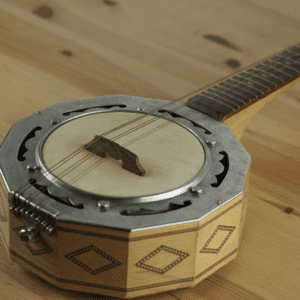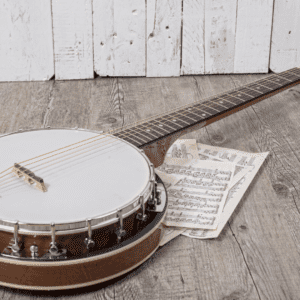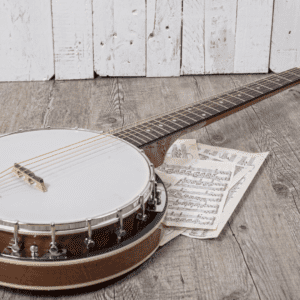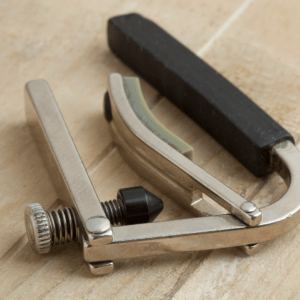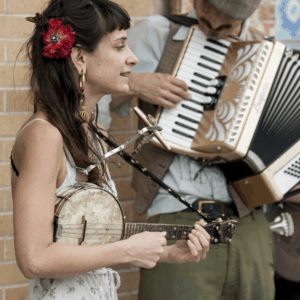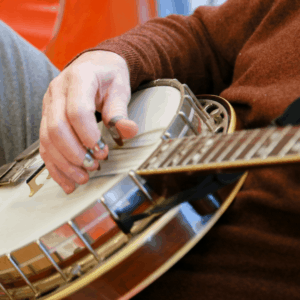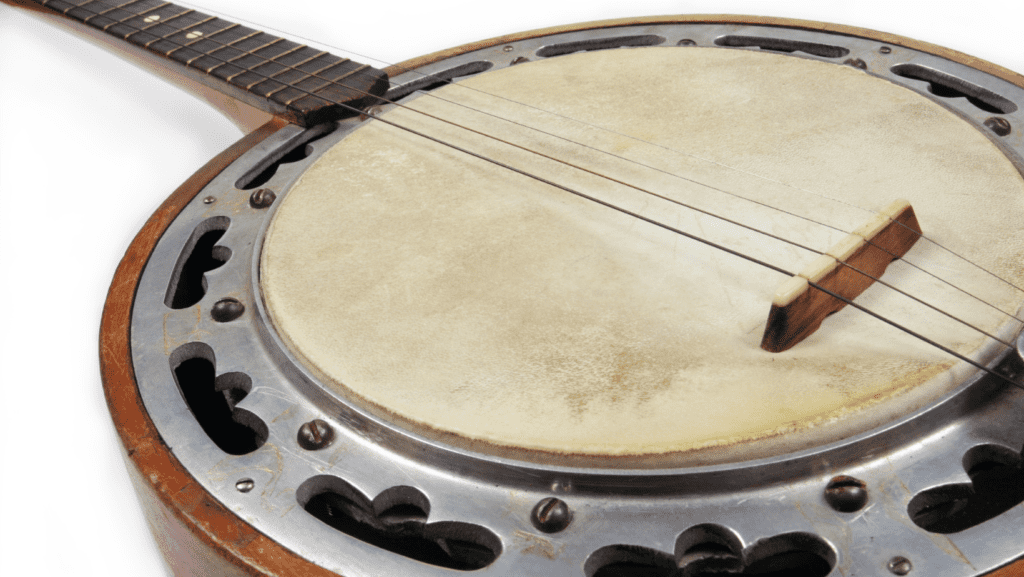
The banjo is a versatile instrument that has its roots in West Africa and is popular in many types of folk music throughout the world. Banjos were initially very simple hide-covered string instruments, but have developed in complexity as time has passed. Innovations in the different components of the instrument have allowed players to attain more virtuosity and get more out of the instrument.
A banjo, like anything else, is the sum of its parts. Aside from having a well-made banjo from good quality materials and good strings, the bridge is ultimately what brings everything together. It’s what transfers the sound vibrations from the strings to the head, where it is amplified and eventually reaches the listener’s ears.
Let’s take a look at some different banjo bridges for you to consider.
| 1.Best Banjo Bridge Editors Choice – Golden Gate GB-1 Standard 5-String Banjo Bridge – 1/2″ A quality made bridge by a reputable brand suited to new and vintage banjos alike | Buy on Amazon | |
| | 2.Best Banjo Bridge For Bluegrass – Golden Gate GB-3 Deluxe 5-String Banjo Bridge – 1/2″ An affordable bridge with ebony and bone inlays with good tonal articulation. | Buy on Amazon |
| | 3. Best Value Banjo Bridge – Swhmc Maple Ebony 4 String Banjo Bridge Classically designed bridge with a maple bottom and ebony top. | Buy on Amazon |
| | 4.Best Clawhammer Banjo Bridge – Grover Compensated Banjo Bridge A compensated bridge that helps you get the right harmonics. Suitable for clawhammer as well as other playing styles. | Buy on Amazon |
| | 5. Best Open Back Banjo Bridge – Golden Gate GB-5 Compensated 5-String Banjo Bridge A beautifully designed compensated bridge that allows you to get the right intonation when you need it. | Buy on Amazon |
5 Best Banjo Bridges Reviewed
Best Banjo Bridge Editors Choice:- Golden Gate GB-1 Standard 5-String Banjo Bridge – 1/2″
Golden Gate is the go-to brand for many serious musicians when it comes to bridges. The GB-1 is made from hard maple and produces a clear tone. The top is made from ebony and effectively transmits the sound vibration to produce an overall pleasing and balanced sound.
Golden Gate bridges are highly durable and should be of service to you for years to come. The GB-1 is ½” high, and is suited to both vintage banjos and more contemporary models too. The affordability of this model alongside its tonal production and sustain make this a favorite for all kinds of banjo players, regardless of the style you play.
Pros
- High-quality construction
- Made by a reputable brand.
- Suited to both vintage and contemporary models.
Cons
- Some complain the string notches are the incorrect width.
Best Banjo Bridge For Bluegrass:- Golden Gate GB-3 Deluxe 5-String Banjo Bridge – 1/2″
The Golden Gate GB-3 Deluxe 5-String Banjo Bridge 1/2″ is one of the best banjo bridges in its range and is suitable for nearly all banjo players. Regardless of whether you’re new to playing bluegrass or a seasoned professional, the build quality, design, and materials of this bridge are sure to impress you.
The Golden Gate GB-3 Deluxe 5-string banjo bridge features a close-grained, hard maple base for smooth and true tonal reproduction. The top of the bridge is made from ebony and bone inlays and the strings notches are clearly pre-cut to aid in tonal articulation.
Pros
- Highly regarded in the banjo world.
- Affordable price.
- Ebony and bone inlays.
- Pre-cut string notches aid in tonal articulation.
- Suitable for nearly all banjo players.
Cons
- Some customers report chips on bone part on top.
Best Value Banjo Bridge:- Swhmc Maple Ebony 4 String Banjo Bridge
Whilst this bridge is made only for four-string banjos, it’ll fit on just about any instrument. This bridge features the universal three-legged design, featured in many premium banjo bridge designs, so you can rest assured you aren’t just getting an undifferentiated slump of wood. The bridge is well made; features a maple body and an ebony top strip.
The construction of the Swhmc Maple Ebony 4 String Banjo Bridge is on point and holds the strings in place without a problem. For banjo players looking to customize their setup without breaking the bank, this bridge should do the trick. Built with the same design principles as high-end models, you can’t go wrong.
Pros
- Popular three-legged design.
- Built just like high-end models.
- Maple bottom and ebony top.
Cons
- Difficult to get used to at first.
Best Clawhammer Banjo Bridge:- Grover Compensated Banjo Bridge
The Grover Compensated Banjo Bridge is tall, standing at ⅝” high. Made from quality materials like selected maple and a compensated ebony top. The bridge is easily adjustable, making life easier for gigging or session musicians, or those who jam regularly with others.
The Grover Compensated bridge both produces and sustains sound beautifully. The height of the bridge, being slightly higher than half an inch helps get the right tone and harness the harmonics of each tonal articulation. All this makes this bridge suitable for many kinds of banjo players and styles, including clawhammer.
Pros
- Easily adjustable.
- The compensated bridge helps produce and sustain sound and get the right harmonics.
- Suitable for many playing styles, clawhammer included.
Cons
- May require some adjustment to get the sound you want.
Best Open Back Banjo Bridge:- Golden Gate GB-5 Compensated 5-String Banjo Bridge
The Golden Gate GB-5 Compensated 5-String Banjo Bridge provides accurate intonation, no matter what style of music you play. Compensation comes by raising the string rest, which will give you just the tonal articulation you’re looking for. It features the popular 3-legged design, with a fine-grained maple bottom and topped with spotless ebony which provides a luxurious aesthetic.
Pre-cut string loops are included, and the ½-inch height makes it suitable for almost all banjos. Because the bridge is compensated you can almost be guaranteed spot-on intonation and pleasing harmonics as well as staying in tune.
Pros
- Compensated bridge gives good intonation.
- Fine-grained maple bottom and spotless ebony top gives a luxurious look.
- Suitable for many musical and playing styles
Cons
- Some complaints about the finish of the wood.
Banjo Bridge Buying Guide And Frequently Asked Questions.
What Does A Banjo Bridge Do?
Put simply the main function of a banjo bridge is to transfer the vibrations of the strings to the head of the banjo. Without a good quality bridge, no matter how well built your instrument is it won’t sound its best.
A bridge is the final piece of a puzzle as to how good your instrument sounds. Without a good quality bridge properly set up your banjo will fail to sound its best. Changing the bridge on your banjo can also breathe new life into an otherwise tired instrument.
How Do You Choose A Banjo Bridge?
Look for a bridge that’s quality made out of good wood, compatible with your banjo, and is durable. If you choose a bridge that is higher or lower than the heel cut on the neck of your banjo then you’ll run into problems with the action.
The action is the height of the strings from the fretboard. The action dictates how easy it is to fret notes as well as the intonation. Lower action, whilst easier to play can lead to problems with intonation and fret buzz. Action that’s too high can be too difficult to play.
What Are The Different Types Of Banjo Bridges?
The main types of banjo bridges are compensated bridges, flat bridges, and radiused bridges.
Compensated Bridges
Compensated bridges are the most common types of bridges on the market. A compensated bridge is tailor-made for accurate intonation. For the best intonation on the banjo, technically speaking each string should be a different distance from the nut, with strings 1 and 5 closest, and 2 and 4 further back towards the tailpiece. String 3 is the furthest away.
These types of bridges tend to have an arc shape to facilitate this difference of each string from the nut. Others use a small stair-step, whilst others use a little ‘v’ shape to facilitate the difference of string number 3.
These types of bridges are popular with people with good ears or perfect pitch who can hear how the intonation is always slightly off on traditional flat bridges.
Flat Bridges
Flat bridges are very user-friendly and are very easy to get used to. As the name suggests, flat bridges have a flat upper and bottom part, unlike compensated bridges. Flat bridges are used on the majority of banjos worldwide.
Flat bridges make pressing down on the string slightly harder than with a radiused bridge, but this is something you can easily get used to, as many string players across the ages on all different kinds of instruments have done.
Radiused Bridges
Radiused bridges feature a curved top edge that matches the curve of the fretboard of your banjo. This curvature makes it easier to fret the strings than on a typical flat bridge and thus is easier on your fingers.
What To Do If A String Won’t Stay On A Banjo Bridge?
If the string won’t stay in place, you can deepen the string notch in the bridge by holding a string at both ends and pulling it back and forth, as if you were flossing your teeth. This can help deepen the groove and keep the string in place. Careful not to overdo it though.
Where To Place A Banjo Bridge?
A banjo bridge should be placed the same distance away from the 12th fret as the nut is to the 12th fret.
Banjos are delicate instruments and replacing the head can be a tricky and time-consuming process. For this reason, banjos are shipped without the bridge set up, as this could cause damage in the shipping process. It’s a good idea to know how to set up your bridge yourself.
To set up a bridge you’ll need a ruler (at least 18” long) and a pencil. First off you need to find out the scale of your instrument. To do this, you need to measure the length from the nut to the 12th fret. The scale length of your banjo is twice the amount of this measurement.
To figure out where the bridge goes, measure from the 12th fret on the treble side and mark with your pencil the same length you measured from the nut to the 12th fret. So if your banjo was 13 ¾” from the nut to the 12th fret, then measure this same distance from the 12th fret. Then do the same from the bass side.
Some people place the bass side slightly further back (1/16”) to compensate for the difference in the string diameter between the thicker bass strings and the thinner treble strings. This compensation should help with the intonation of your instrument.
What Happens If The Bridge Is In The Wrong Place?
If your bridge is placed in the wrong place you may run into problems with intonation. If your measurements are off and you place the bridge too close to the tailpiece, you could end up puncturing the drumhead.
An improperly placed bridge will leave you at best, with poor intonation and at worst a broken head. So make sure you get your measurements correct and avoid the hassle and headache of a broken instrument could cause you.
How To Get The Correct Banjo Bridge Height?
Make sure your banjo strings are loose enough and give enough slack so they won’t puncture the head once you stand it up. Once you’ve placed your banjo bridge in line with the marks you’ve made, place the strings in the notches and tighten the strings. The bridge should stand up at the correct height.
Make sure there’s the same amount of distance between the outer treble string and bass string to the edge of the fretboard, and that the feet of the bridge are sitting flat on the head. Failure to make sure the feet are sitting straight could end in you accidentally puncturing the head of the instrument.
To Conclude
A banjo bridge is the final piece of the puzzle in how your banjo sounds. The job of the bridge is to transmit the vibration of the strings to the resonator drum head. To do this it needs to be well made out of good quality materials to effectively and efficiently transmit the sound vibration and produce a good clear and reliable sound.
There are many different types of bridges available for the banjo player to choose from, and what works best for you will depend on many factors including your playing style, experience, how much you play, and the size of your hands.
Last update on 2023-04-27 / Affiliate links / Images from Amazon Product Advertising API


